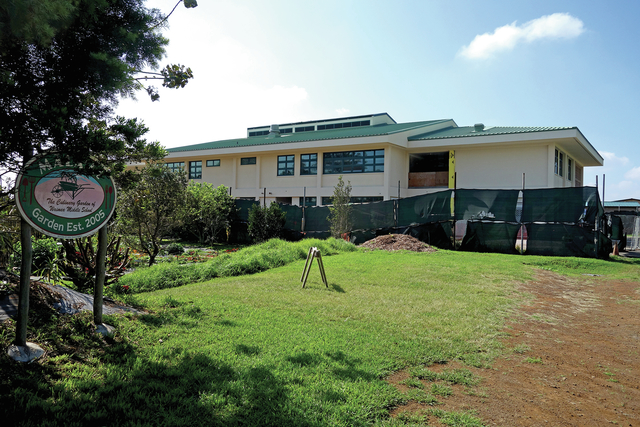WAIMEA — Construction on the $16 million, 9-classroom STEAM building at Waimea Middle School is progressing, with much of the exterior nearly completed now. The 24,000-square-foot, two-story facility — including three science labs — is expected to be completed in May, with classes beginning this fall for the 2017-18 school year.
Work on the interior has begun, with cabinetry installed earlier this month. Electric will be added most likely over spring break, and interior finishing sometime between March and May. A small amphitheater is being built outside, where presentations can be shared during the day and evening.
Originally referred to as a STEM building (science, technology, engineering and math), “A” was added recently to signify “arts” — like other schools have done across the county — stressing the importance in a well-rounded education. In Hawaii, “A” also refers to aina-based, hands-on teaching and learning about the planet and universe.
Nau’i Murphy, a WMS graduate, heads the school’s science department. She has looked for ideas at other schools on Hawaii Island and Oahu.
“The science department has been exploring what Honokaa, Kealakehe, Punahou, Iolani, Kamehameha and mainland schools have done for their science buildings’ design,” she said. “We are happy with what we’re seeing coming with the Next Generation Science Standards (NGSS) because it’s going to be more model making, process and products. We’re asking kids to do things and think about world problems in a logical manner.”
Having been born and raised in Waimea, Murphy looks at the bigger picture.
“The important thing to me is to continue to support our community and make this a place where kids can find jobs, want to live and be proud,” she said. “I think part of that is creating science projects for our kids that look at our farming, ranching and climate change. We’re trying to figure out projects that are very relevant and important for today’s world.”
Dr. Paul Nakayama is heavily involved in the project as a new WMS board member for Ho’okako’o Corp., a private, non-profit organization that represents the school along with two other charter schools in Hawaii. As a retired science engineer who specialized in applied physics, he has many ideas.
“Learning comes from project-based assignments. It’s not a lecture; you’re going to go do something, apply something,” he said. “We want the students to be able to use ‘toys’ such as chips, thermometers and pendulums that can measure momentum, energy and other algebraic equations. These then sink in more than an equation on the blackboard, and allows them to understand the next level of concepts.”
WMS students will also be able also work on projects outside in the adjacent Mala’ai Garden, similar to what Nakayama saw at his alma mater.
“At Iolani they had a biology/chemistry section where they grow plants with different stimulus,” he said. “Here they have the garden. You can teach chemistry by doing analysis of the soil and see what you’re lacking. That tells you what you need to add, and you can go one step further to make that, such as seaweed and dead grass. They can then do a chemical analysis of all those things and figure out how to blend them to make the fertilizer. By doing an experiment in the garden they’ve learned chemistry.”
In addition to serving more than 250 WMS students, the school hopes to open the building to other schools and the community as well.
“Our goal is that it will become a hub for STEAM teaching and learning to include a professional development center led by a STEAM project coordinator to assist not just our students, but regional educators with implementation of NGSS and Common Core State Standards,” Patti Cook said, WMS’s director of community development.
Funding for the building was acquired in 2012 and 2013 through the state legislature with a CIP (Capital Improvement Program) appropriation that included environmental assessment and construction. However, this did not cover hardware or software for items such as computers and 3D printers, or funds to hire a STEAM coordinator that would run the program and lead professional development.
WMS now needs an additional $1.5 million over the next four years to cover these costs.
“We have applied for a Kamehameha STEAM grant and should receive notification by the end of March,” said WMS Principal Amy Kendziorski. “We are constantly looking for other funding sources too that are available. To do innovative things we will need additional staff to offer different classes and enrichment learning opportunities. How big or how small definitely depends on some funding partners and their expertise. We must do some asking on behalf of children and their education.”
A community meeting is being planned for February or March to share more details with families, alumni and residents.
Info: www.facebook.com/WaimeaMiddleSchool



